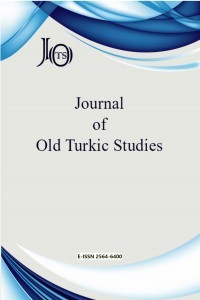Kısasü’l-Enbiyā’da Oğuz Diyalekti Unsurları Üzerine
Qiṣaṣ al-Anbiyāʾ, Old Turkic, Kharezm Turkic, Oghuz Turkish Elements
On Oghuz Dialectic Elements in Qiṣaṣ al-Anbiyāʾ
Qiṣaṣ al-Anbiyāʾ, Old Turkic, Kharezm Turkic, Oghuz Turkish Elements,
___
- Ağca, F. (2021). Uygur Harfli Oğuz Kağan Destanında Oğuzca Unsurlar. In Azılı, K. et al. (Eds.), Oguz Bitig: Modern ve Tarihsel Oğuzca Üzerine Araştırmalar (pp. 20-32). Ankara: Bilge.
- Ata, A. (1997). Kısasü’l-Enbiya (Peygamber Kıssaları): Giriş-Metin-Tıpkıbasım, Dizin I-II. Ankara: Türk Dil Kurumu Yayınları.
- Ata, A. (2002). Harezm-Altın Ordu Türkçesi. İstanbul: Türk Dilleri Araştırmaları.
- Caferoğlu, A. (1994). Türk Dili Tarihi I-II. İstanbul: Enderun Kitabevi.
- Doerfer, G. (1975-1976). Das Vorosmanische (Die Entwicklung der oghusischen Sprachen von den Orchoninschriften bis zu Sultan Veled). Türk Dili Araştırmaları Yıllığı Belleten, 23-24, 81-132.
- Erdal, M. (2015). Ana Oğuzca ve Selçuklu Oğuzcası. In Gündüz, T. & Cengiz, M. (Eds.), Oğuzlar Dilleri, Tarihleri ve Kültürleri 5. Uluslararası Türkiyat Araştırmaları Sempozyum Bildirileri (pp. 369-376). Ankara: Hacettepe Üniversitesi Türkiyat Araştırmaları Enstitüsü Yayınları.
- Gülsevin, G. (2010). Oğuzca Olmayan Türk Lehçelerindeki Oğuzca Unsurlar ve Bunlara Teorik Bir Yaklaşım. Turkish Studies, 5(1), 57-76.
- Korkmaz, Z. (1972). Eski Türkçedeki Oğuzca Belirtiler. I. Türk Dili Bilimsel Kurultayı (pp. 433-446). Ankara: Türk Dil Kurumu Yayınları.
- Stachowski, M. (2014). Protolanguage models, reconstruction methodology, Khakas, Oghuz and English. In Bednarczuk, L. et al. (Eds.), Linguistique romane et linguistique indo-européenne. Mélanges offerts à Witold Mańczak à l’occasion de son 90e anniversaire (pp. 409-428). Kraków: Polska Akademia Umiejętności, Uniwersytet Jagielloński.
- Yayın Aralığı: Yılda 2 Sayı
- Başlangıç: 2017
- Yayıncı: Erdem UÇAR
Müverrih Ebü’l-Ferec’in Yahudi Kökeni ve İbnü’l-İbrī Nisbesi Hakkında
Zum Vergleich der alttürkischen und „germanischen“ Schrift und Kultur
Kısasü’l-Enbiyā’da Oğuz Diyalekti Unsurları Üzerine
Eski Anadolu Türkçesine Ait Bir Hikâye: Ayniddîn’in Dâsitân-ı Hatun Mesnevisi [06 Mil Yz A 3881/6]
Einige Beobachtungen zur Übersetzungstechnik der altuigurischen Maitrisimit
